Why on earth is an IROC Camaro worth more than a C4 Corvette?
There’s a certain order of things in the car industry. Some brands and badges just sit higher up on the totem pole of price than others. A Lincoln is more expensive than a Ford, a Lexus more expensive than a Toyota, a 5 Series than a 3 Series, etc. Convention also dictates that a Corvette is supposed to be pricier than a Camaro.
That’s certainly the case when shopping for new cars in 2022, and it was the case in 2012, 2002, 1992 and way on back. If Chevrolet’s pony car is the working man’s whip, America’s sports car is what the owner of the company he works for drives. If the Camaro is attainable, the Corvette is aspirational. You get the idea.
So what?
When going over our quarterly updates to the Hagerty Price Guide recently, we realized the status quo has been upset for a certain Chevy performance pair, specifically from those mustachioed muscle years of the 1980s.
Not only is a Camaro IROC-Z (1985–90) worth more than the equivalent base C4 Corvette (1984–96), it’s worth a lot more. More than twice as much, actually, and this reversal of things predates both the recent boom in interest for all things ’80s cars and ’80s revival events like Radwood.
We have a major market anomaly on our hands, then. The situation is sort of like booking a guided African safari for cheaper than a trip to the local zoo, or eating at a restaurant whose steak is cheaper than the burger. To try and understand this contradiction, we found a pair of these star-spangled mullet-mobiles—Sajeev Mehta’s 1985 Corvette and Kay Yasoni’s 1988 Camaro IROC-Z —for a back-to-back drive on a (finally) cool fall morning in Houston, Texas.
We wanted to find out if, perhaps, modern car collectors are on to something that wasn’t obvious to General Motors product planners in the 1980s.
That wouldn’t be unheard of. Some of the hottest cars on the market were, at one point, thought to be attainable or less. A Mini Cooper from the 1960s can easily be worth as much or more than some contemporary Rolls-Royces; a Mazda MX-5 Miata can easily bring more money than contemporary Cadillacs and Lincolns—and that kind of makes sense.
This sort of thing happens all the time in other markets. Vincent Van Gogh died a failure. Now his works are priceless.
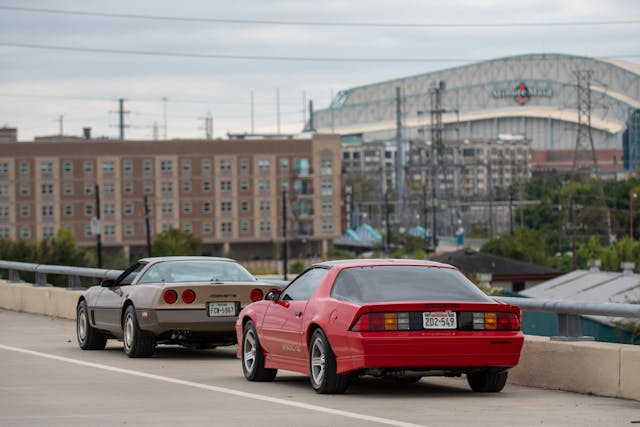
Debuting in 1982 and 1984, respectively, the third-gen Camaro and the fourth-gen Corvette were the right cars at the right time for General Motors. Both of their predecessors were long-in-the-tooth and near-caricatures of their former selves by the early ’80s. Thanks to computer-aided design, fuel injection and more sophisticated suspension, the General finally pulled these American sports cars out of the malaise era.
“We needed to get the Corvette back to the performance level of 1970,” said Dave McLellan, the Corvette’s chief engineer during the C4 years. Chevy mostly pulled it off, with Car and Driver calling the first all-new Corvette in 20 years “a true-born, world-class sports car loaded with technical sophistication.”
The Camaro, meanwhile, was another breath of fresh air that brought a completely new look to Chevy’s pony car, leading Motor Trend to award it Car of the Year honors for 1982.
The Z28 was the speediest Camaro upon the third gen’s debut in 1982, but from 1985 to ’90 the top dog in the lineup was the IROC-Z Sport Equipment package, often shortened by funny-haired gearheads everywhere to simply “IROC.”
The $659 option took its name from the International Race of Champions, a race series pitting the stars of NASCAR, Indy, and sports car racing against each other in identical Chevy Camaros.
The actual IROC race cars weren’t much more than Camaro-shaped shells on top of a NASCAR tube chassis. But, like any good car company, Chevrolet was never one to miss a marketing opportunity and slapped IROC decals and a body kit on its latest flagship Camaro. Uprated suspension, bigger sway bars, upgraded wheels and tires, fog lights, and a choice of V-8 engines came with the stickers.
For the second half of the 1980s, the IROC was the Camaro to have, with the most power and, of course, the most flash.
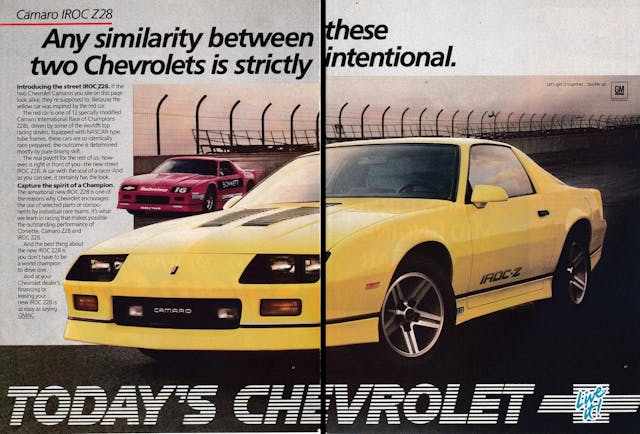
For 1988, Chevrolet slimmed down the Camaro lineup by dropping the LT and Z28 models, leaving only the base coupe and the IROC-Z. Although a taller final drive was paired with the 350 engine, its output kept rising, up to 245 horses for 1990. The International Race of Champions series began using Dodge Daytonas in the ’90 season, so Chevy dropped the IROC-Z package in 1991, reinstating the Z28 as the range-topper.
Owner Kay Yasoni’s IROC is a bone-stock, Bright Red ’88 model with the desirable L98 350 and T-tops, and it has gotten the kind of restoration work normally seen on older, more valuable pony cars. Maybe it’s the color, or maybe it’s because I haven’t seen such a clean third-gen Camaro in 20 years, but this car looks fantastic, even next to the Corvette that was supposed to be the premium offering. Its wedgey angles have aged well.
The inside is straightforward ’80s GM (plastic, lots of plastic) with gray cloth seats and right angles everywhere with square vents, stereo, and switchgear. The only things that are round, other than the leather-wrapped steering wheel, are the simple gauges—speedo on the left, tach on the right, and auxiliary readouts in the middle. It’s more restrained than one might expect for a decal-laden performance car named after a race series, but it is functional.
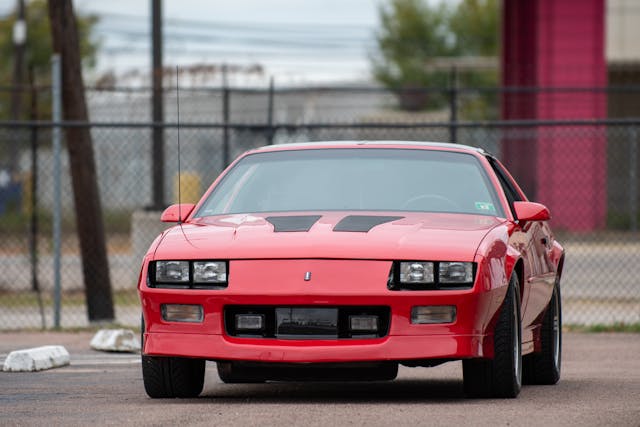
Easy-to-remove glass T-tops offer a clear view of the sky above, and aside from a hint of red fenders and hood vents, there’s a panoramic view of the road ahead as well. I may have forgotten my Whitesnake cassette, but it turns out I didn’t need it—driving this IROC turns back the clock plenty.
As a performance car, the IROC both then and now leaves something to be desired. As a time machine, though, it’s hard to beat. It’s a fun car that people fall in love with it because it brings back memories and feels very of-its-era.
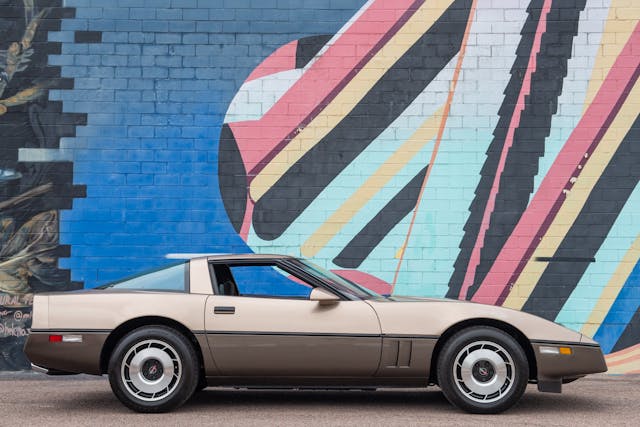
The crisp body produced 24 percent less drag than the C3, the rear hatch offered more space for luggage, and the clamshell hood offered more room to service the engine. A “uniframe” chassis combined a traditional rail frame with separate frames for the windshield and B-pillar. A removable targa roof bolted in between the A- and B-pillars.
Front A-arms and spindles were computer-designed and for the first time and made from forged aluminum, while the compact multilink rear suspension sported a transverse fiberglass leaf spring. An all-digital instrument cluster gave off Tron vibes in a time when most cars had only recently gotten an itty-bitty digital clock.
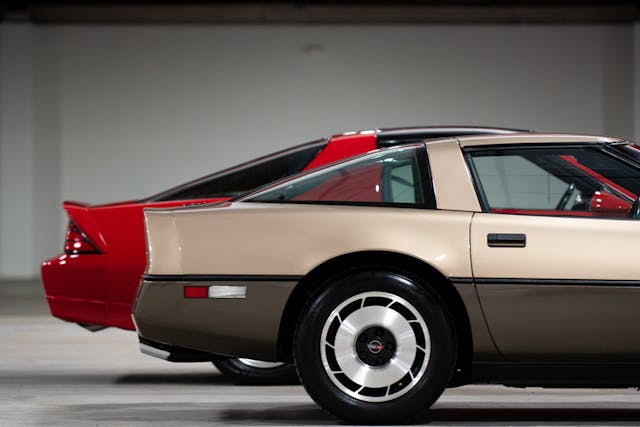
Despite that, initial reviews complained of the new Vette’s jarring ride as well as incessant creaking and rattling from the plasticky cabin. GM improved the ’85 Corvette’s ride with softer spring rates, while the 350 cubic-inch, 230-hp L98 engine debuted under the hood. The workhorse L98 would power the base Corvette until it was replaced by the 300-hp LT1 in 1992. Transmissions were still either automatic or, from 1984-88, a “4+3” manual built by Doug Nash that was essentially a traditional four-speed with overdrive on the top three gears.
And even though the IROC has a racy name, the Corvette wouldn’t be America’s sports car without some motorsports history of its own to back up those crossed flags on the hood.
In SCCA Showroom Stock GT racing, C4s swept the Playboy and then Escort Endurance Championship from 1985–87, and there was nothing the Porsche 944 Turbos could do to stop them. So dominant were the Corvettes that they were booted into the single-marque Corvette Challenge series.
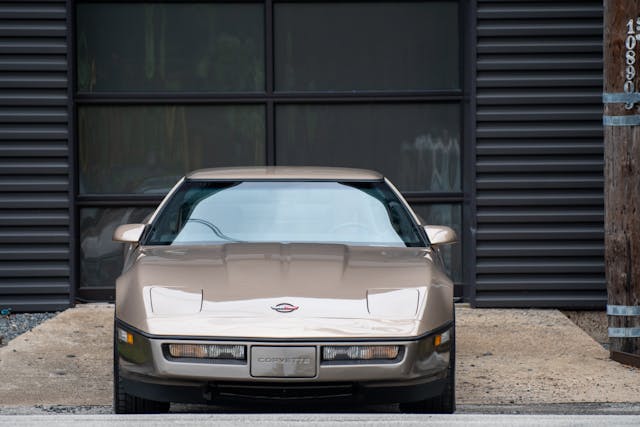
The enormous door sills make getting in and out of a C4 a challenge for anyone, least of all for the 50-somethings who typically buy Corvettes. They say you shouldn’t wear a skirt when driving one of these cars, but it’s awkward no matter what you’re wearing.
If the Camaro’s interior is a cabin, the C4’s is a cockpit. A slightly cramped one that nestles you in between the aforementioned sill and an equally tall transmission tunnel, the green and orange glow of that arcade-game instrument cluster greeting you from behind the two-spoke steering wheel.
If squeaks and rattles were standard factory equipment on the C4, as the old joke goes, they left them out when building this one. It was no noisier than the Camaro. We didn’t take the roof off, though, which in a C4 allows the body to flex and creak through corners and over bumps.
Even with the roof on, a C4 lumbers and rolls through corners more than one might expect, feeling planted but certainly not light on its feet. Step on the go-pedal, though, and the car livens up, feeling as though its 230-horse, 330 lb-ft torque ratings are delivering more than what the digital speedometer is reading (a hybrid-analog-digital dash arrived in 1990; dim or failing gauges are common on the earlier cars).
These two bowties weigh within a hundred pounds of each other and share the L98 engine, but the Corvette feels considerably quicker.
When the ’80s kitsch falls away, you’re left with a more purposeful sports car than the contemporary Camaro. The Corvette is lower, quicker, more exciting. It’s a more entertaining experience behind the wheel whether you’re driving it or sitting in traffic. Even the interior’s gimmicks and eccentricities lend a sense of occasion missing in the IROC’s sea of plastic.
Of course, this is as it should be. The Corvette was then, as now, GM’s performance flagship and cost more than even a loaded IROC when new (an IROC could get to $20K with options, but the ’85 Corvette started at $24K).
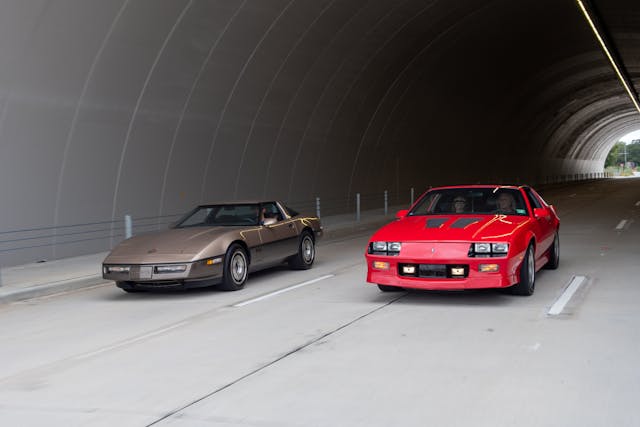
Why are low-mile IROCs storming through Bring a Trailer for prices over $40,000 and even $60,000 while base C4s in similar condition are lucky to sell in the 20s?
There isn’t one big answer, but there may be a few smaller ones. One is the rarity of good-condition IROCs. Chevrolet sold third-gen Camaros by the lot, but IROCs were expensive. Kay’s red coupe is one of 24,050 IROC-Zs sold in 1988, but only about half of that number came with the big engine.
Also, many IROCs lived hard, well-used lives, and as they aged they were frequently left to the elements. Meanwhile, Sajeev’s C4 is one of nearly 40,000 Corvettes sold for ’85, and if the typical IROC buyer was out looking for a stop light drag, the Corvette owner was a middle-aged family man who only drove it on the weekends. As such, the C4 survival rate is higher, the typical mileage lower.
There’s also the fact that while the IROC-Z is top dog among third-gen Camaros, an early C4 has to look at the taillights of Callaways, ZR-1s, Grand Sports, and even later base cars. Mehta’s bronze beauty is a very nice car, but it’s no “King of the Hill” ZR-1 (although even ZR-1s remain relatively affordable).
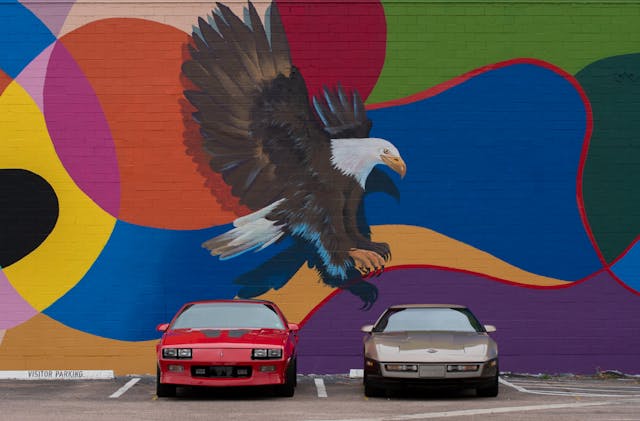
Meanwhile, Gen Xers apparently go gaga for third-gen Camaros. Although Gen Xers make up 32 percent of the market as a whole, they own about half of the IROCs insured with Hagerty. IROC values started to soar in 2014, about when this generation of enthusiasts entered their high-earning, mid-life, fun-car-buying years. That’s probably not a coincidence.
Last but not least, there are impossible-to quantify matters of perspective. Even with the old jokes about mullet-wearing owners, these Camaros really play to nostalgia—a powerful force in any collector market. For those of a certain age, the IROC was the attainable car they dreamed of—the car the coolest kid in your high school might have driven. The C4 Corvette, rightly or wrongly, may be remembered as something your buddy’s dad drove, probably while wearing New Balances and high socks.
Even the C4’s technological advancements might work against it in the minds of collectors. It hails from an era when General Motors squandered a fortune on technical solutions, from paint-shop robots that wound up spraying each other to plastic-bodied compact cars that couldn’t match the refinement of contemporary Hondas. It’s also sort of stuck in a middle ground where it’s too new and electronic to really be considered a “classic” in the sense of a C3, but at the same time it lives in the shadow of the much faster (and today not much pricier) C5.
I still don’t get it, though. The massive gulf in value between these cars that used to share showroom space is just too big to make sense, and if one is undervalued, maybe the other is overvalued. Either way, it’s yet another case of why the car hobby is not always a rational one.
Check out the Hagerty Media homepage so you don’t miss a single story, or better yet, bookmark it.

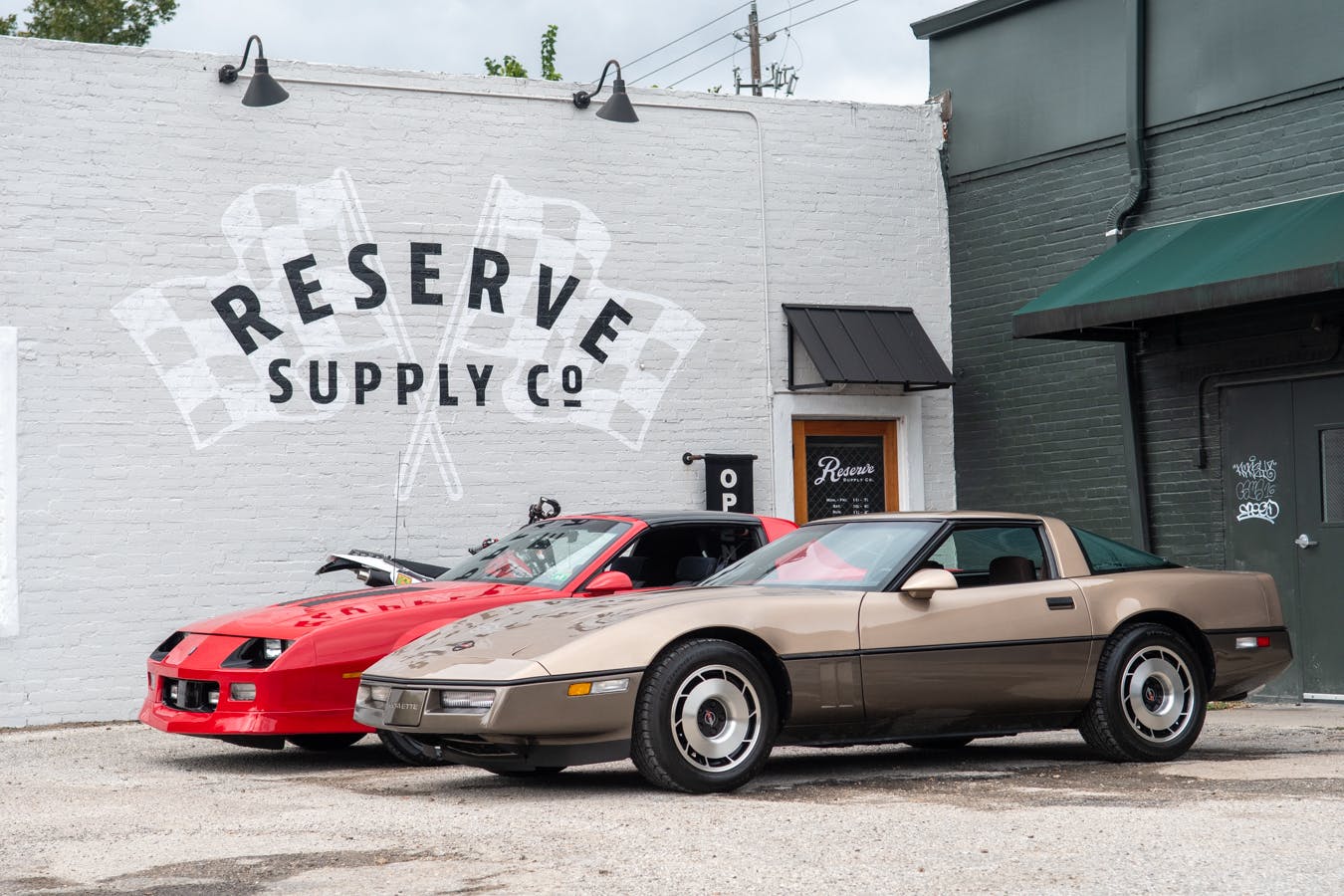


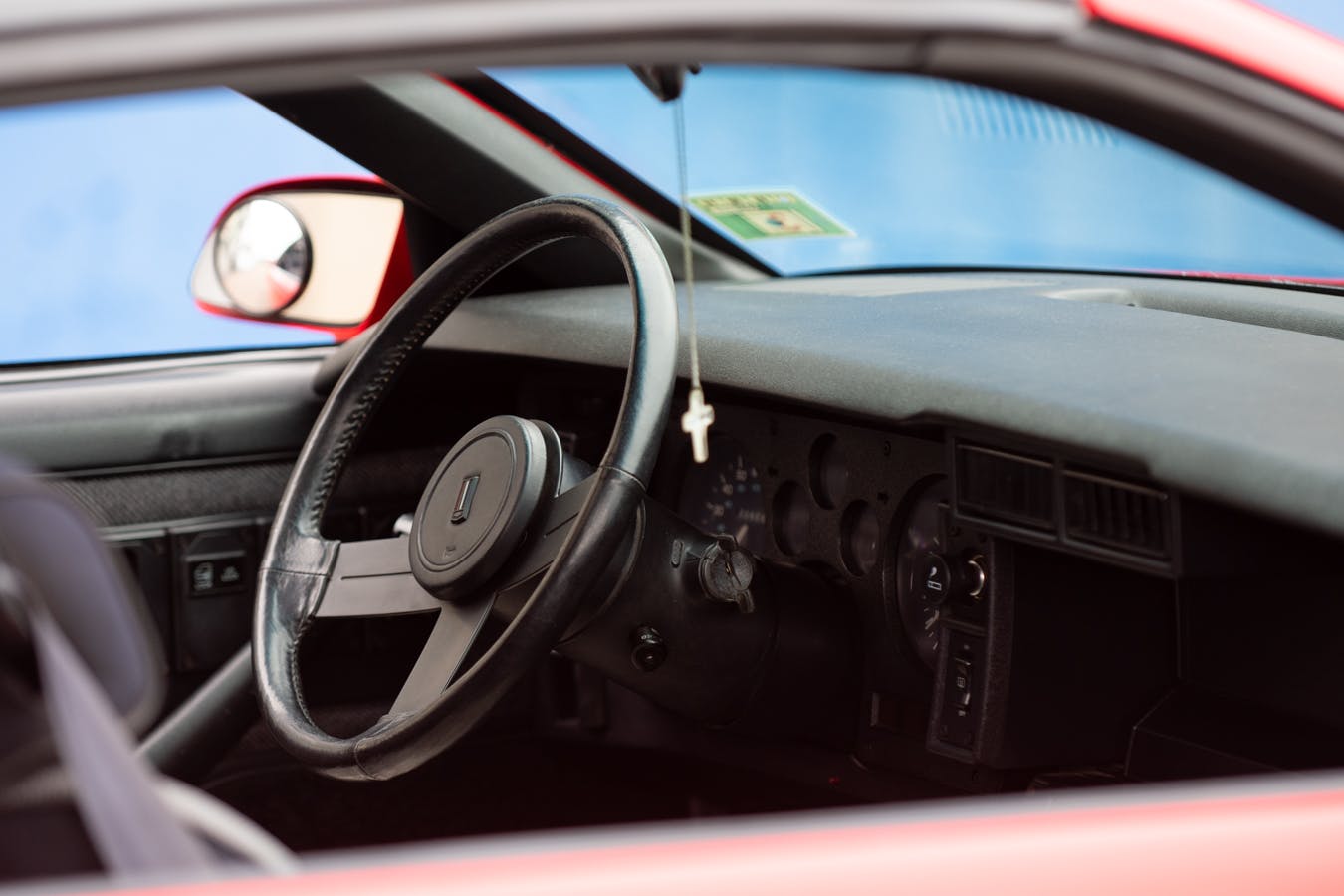
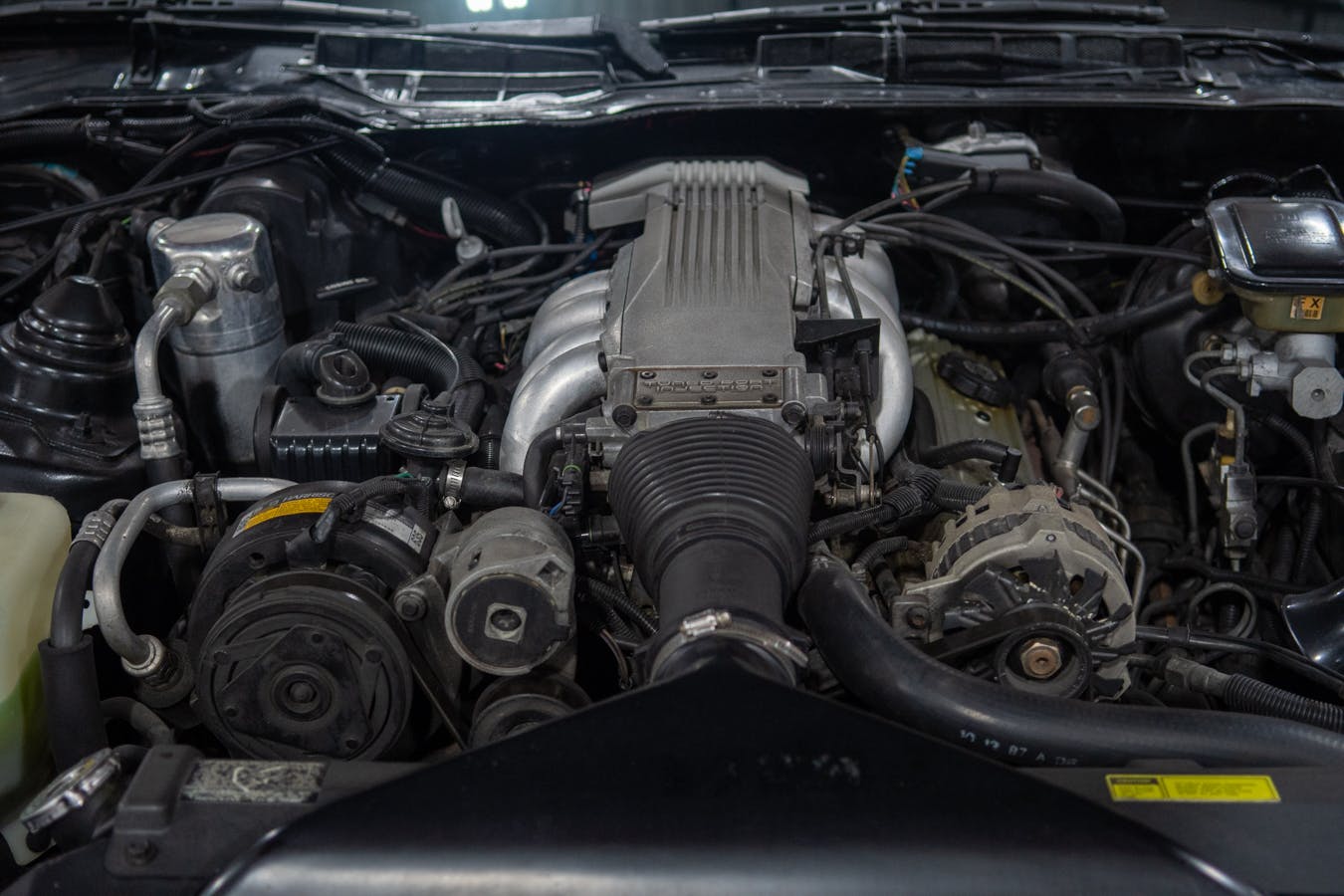
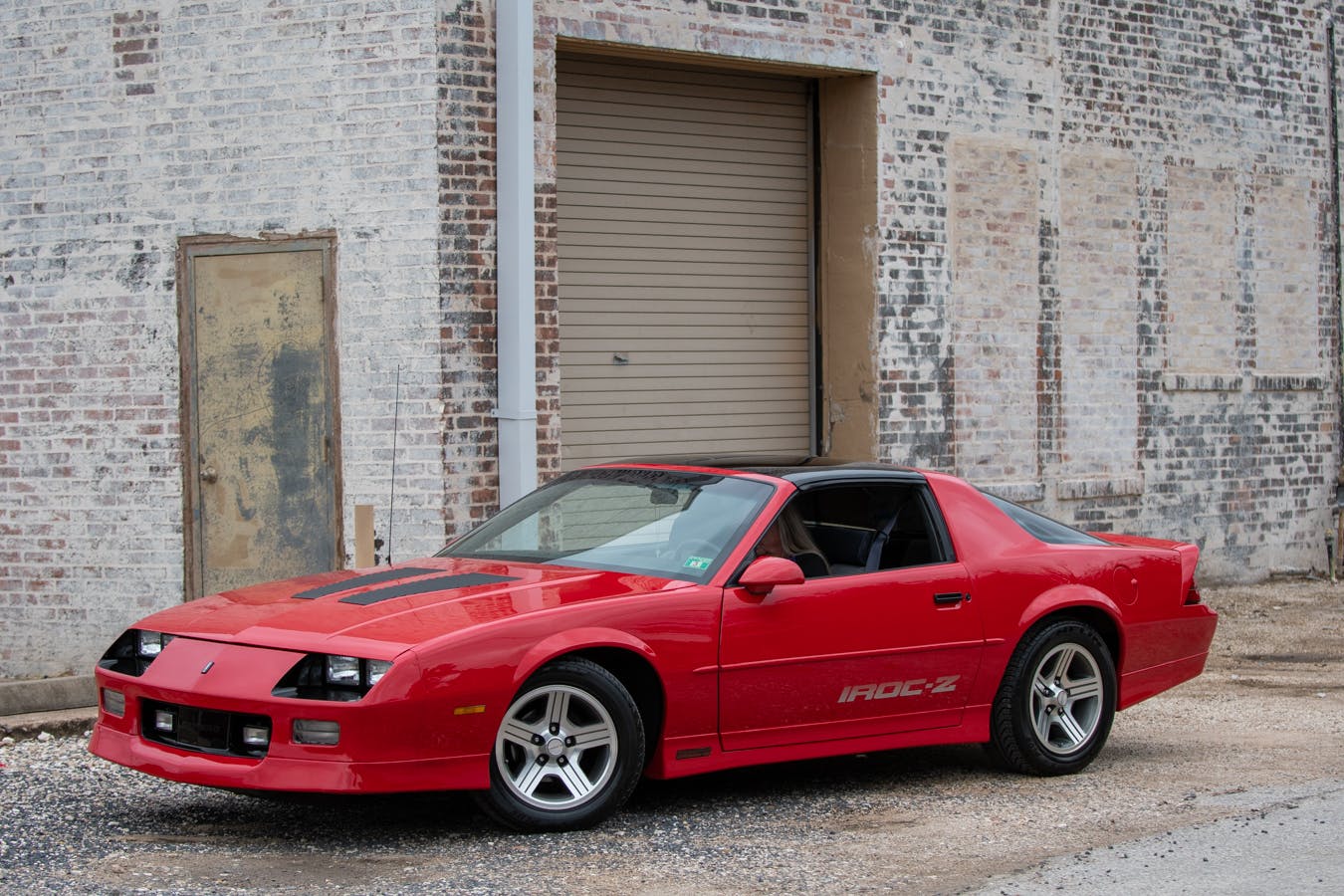
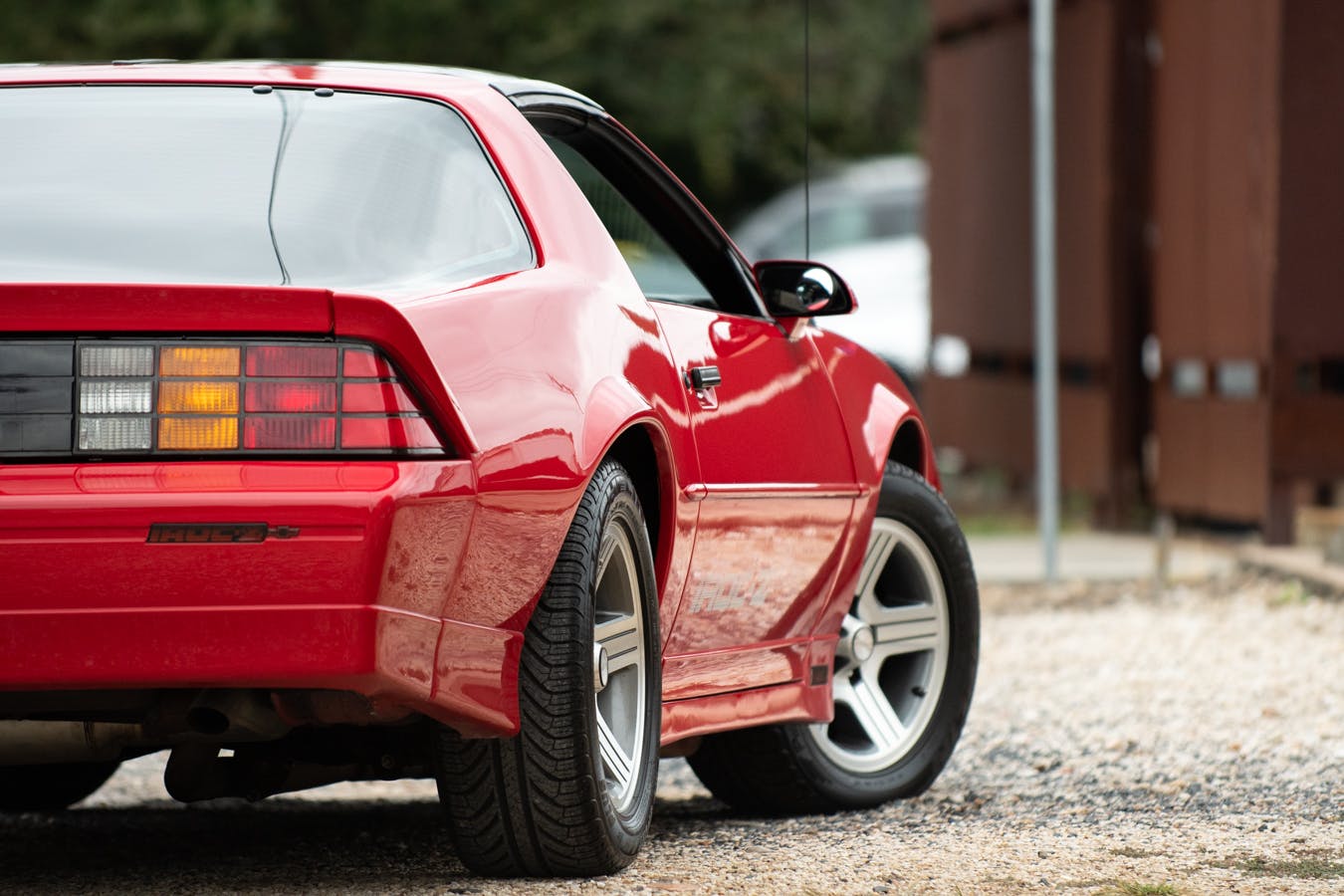
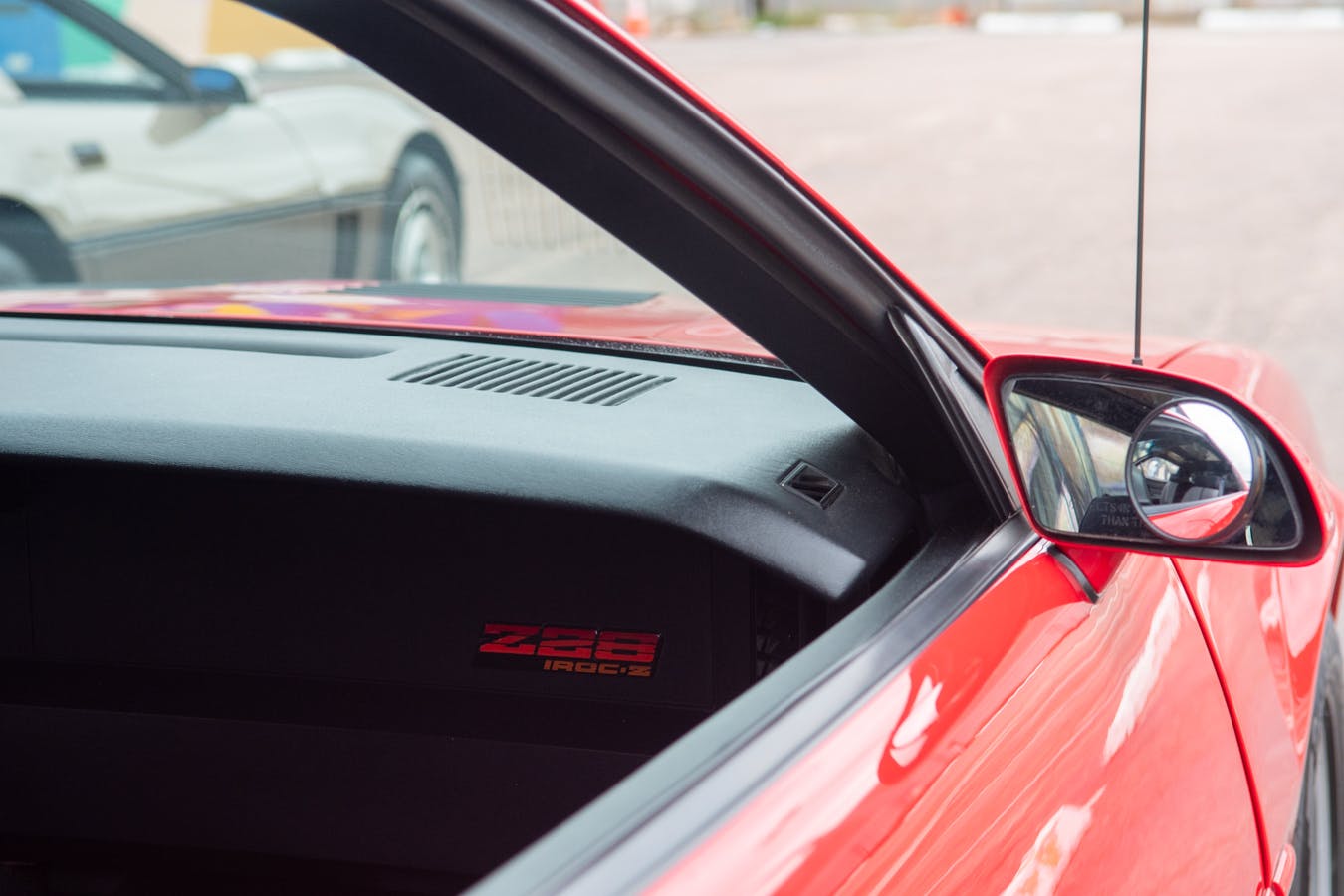
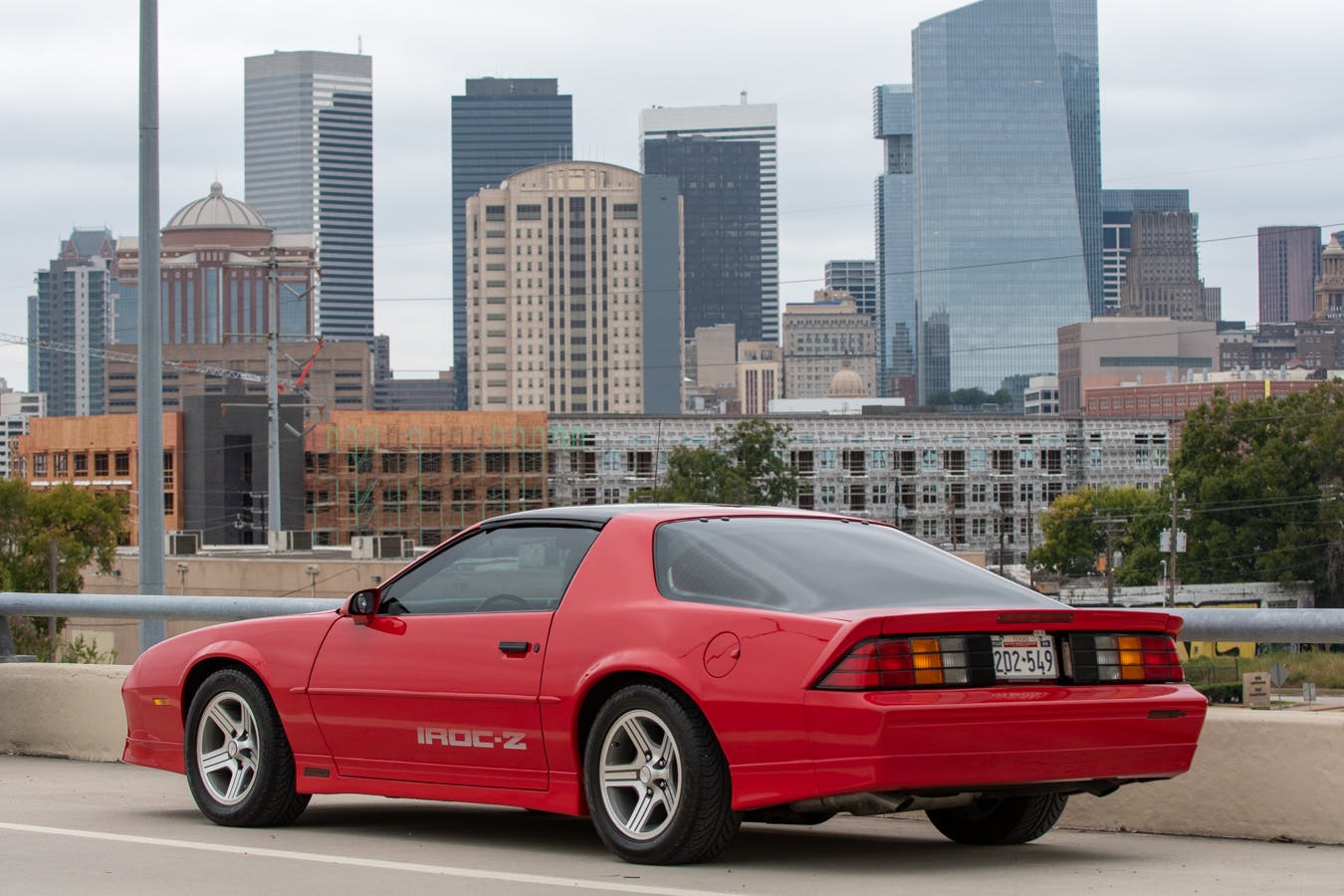
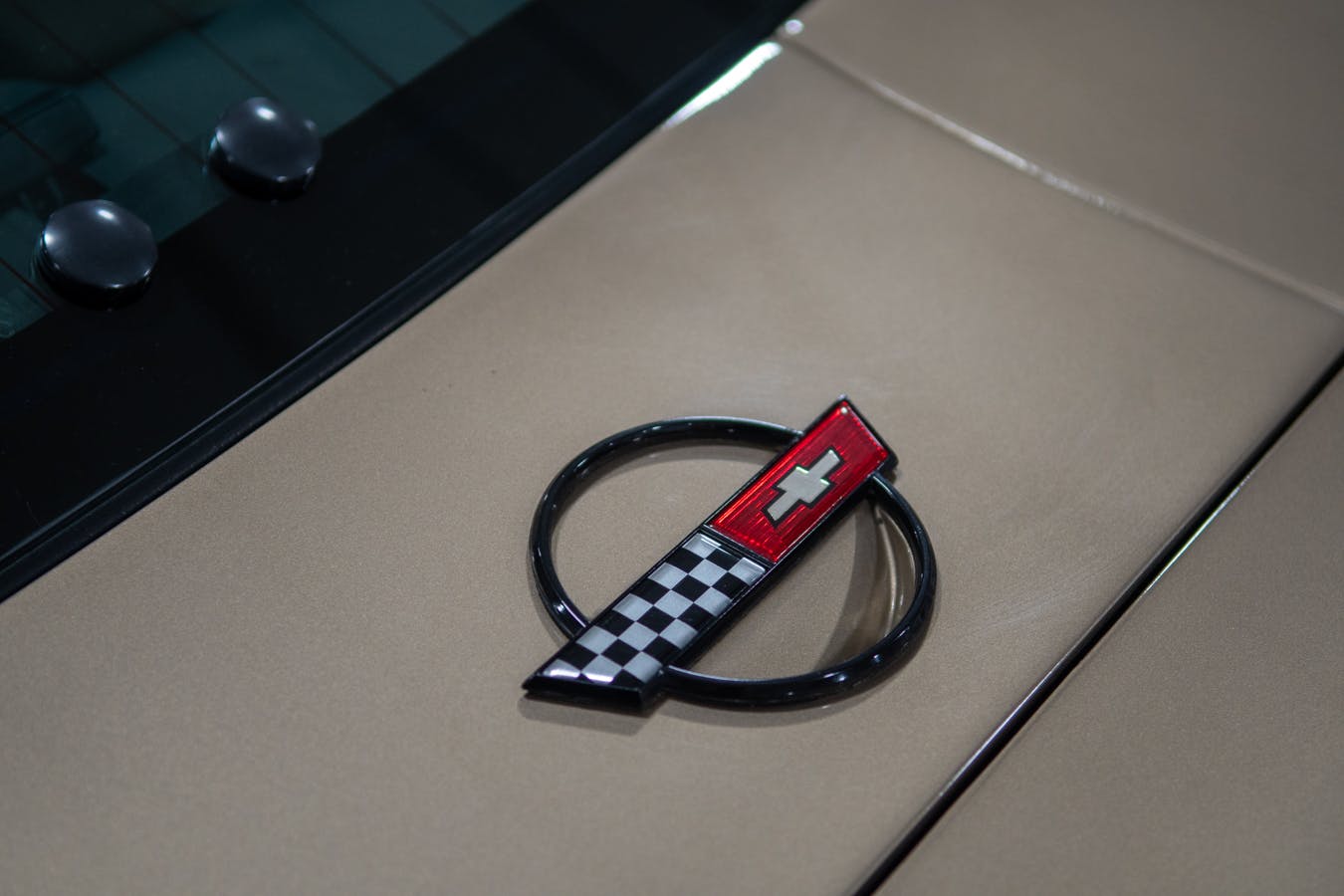
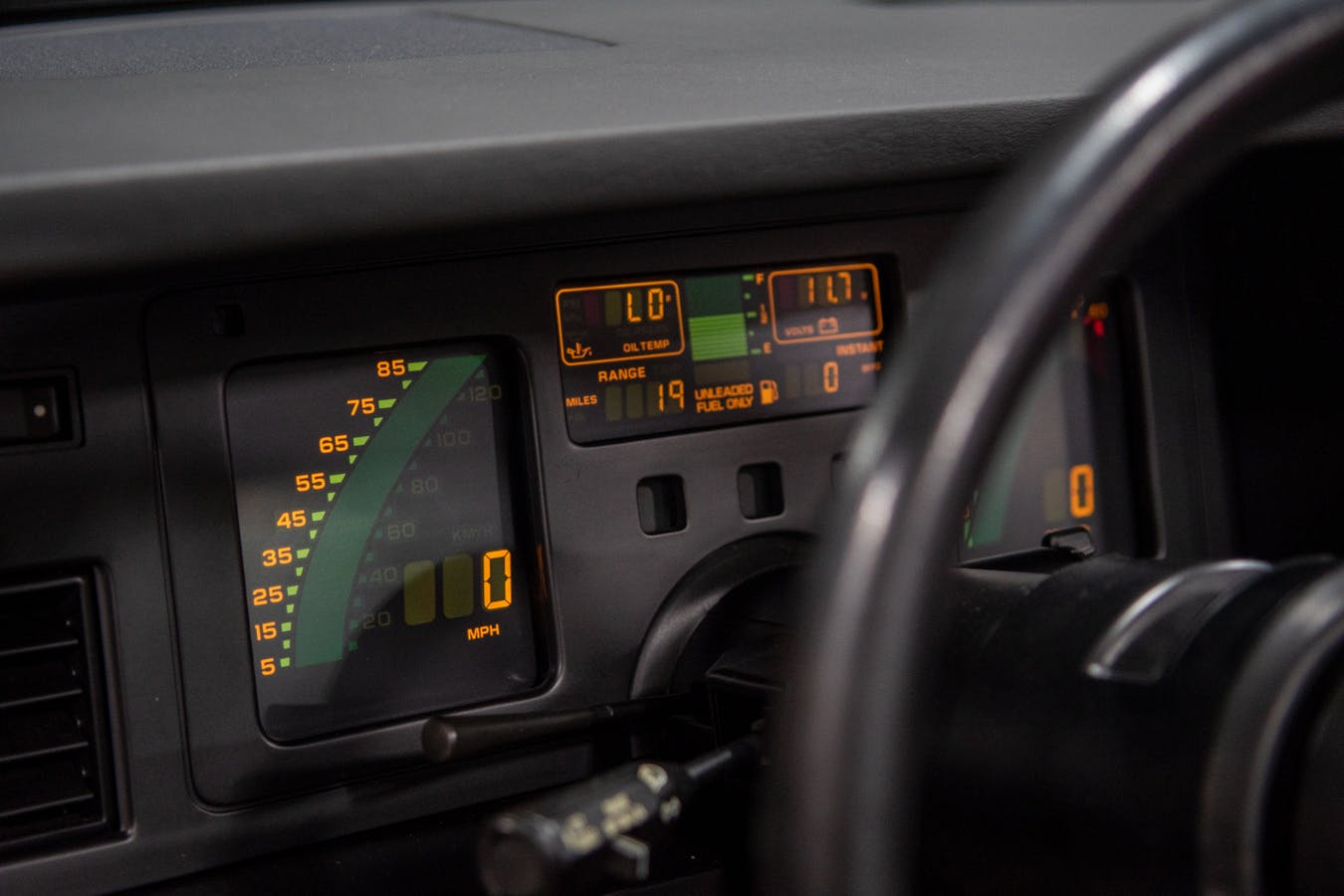
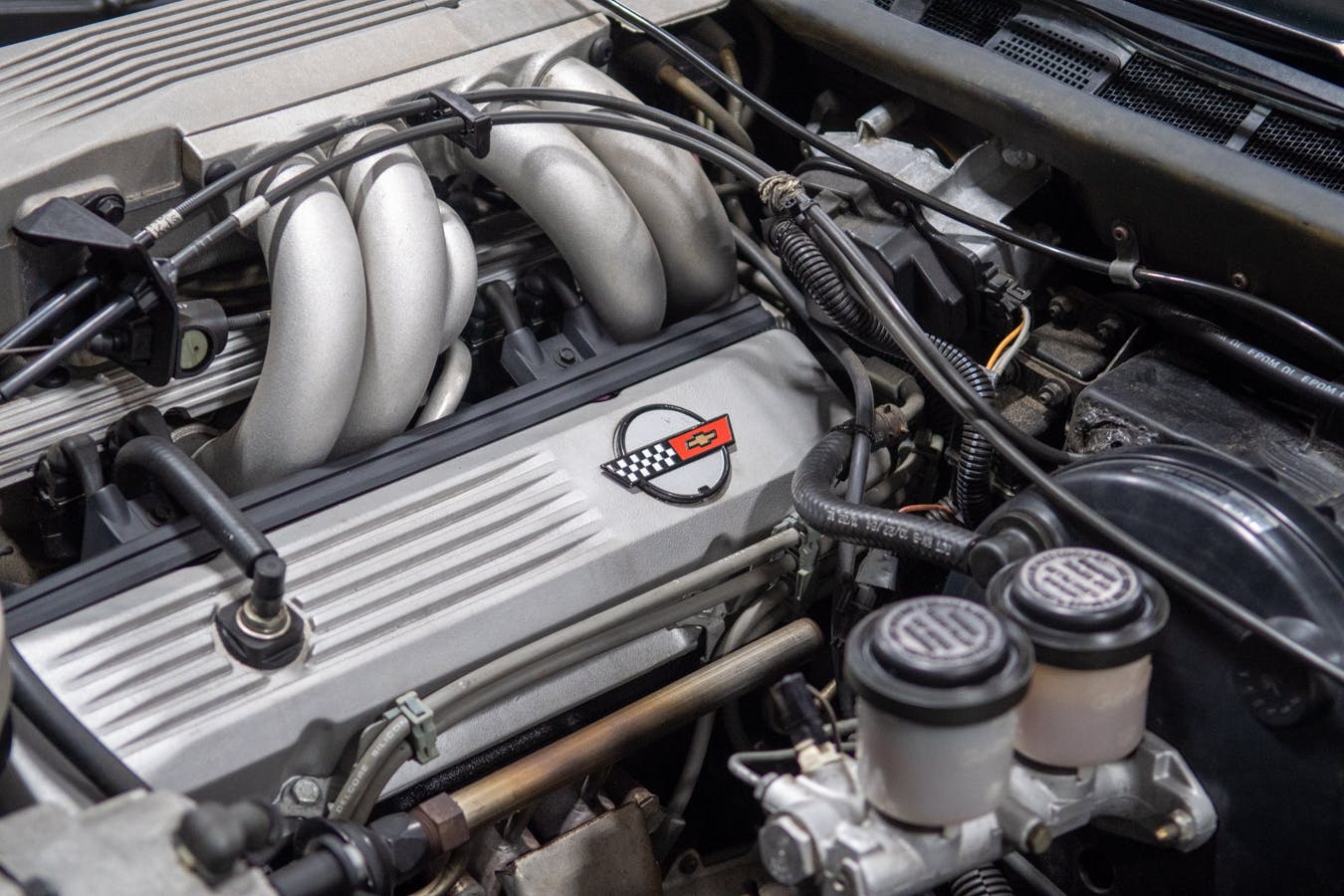

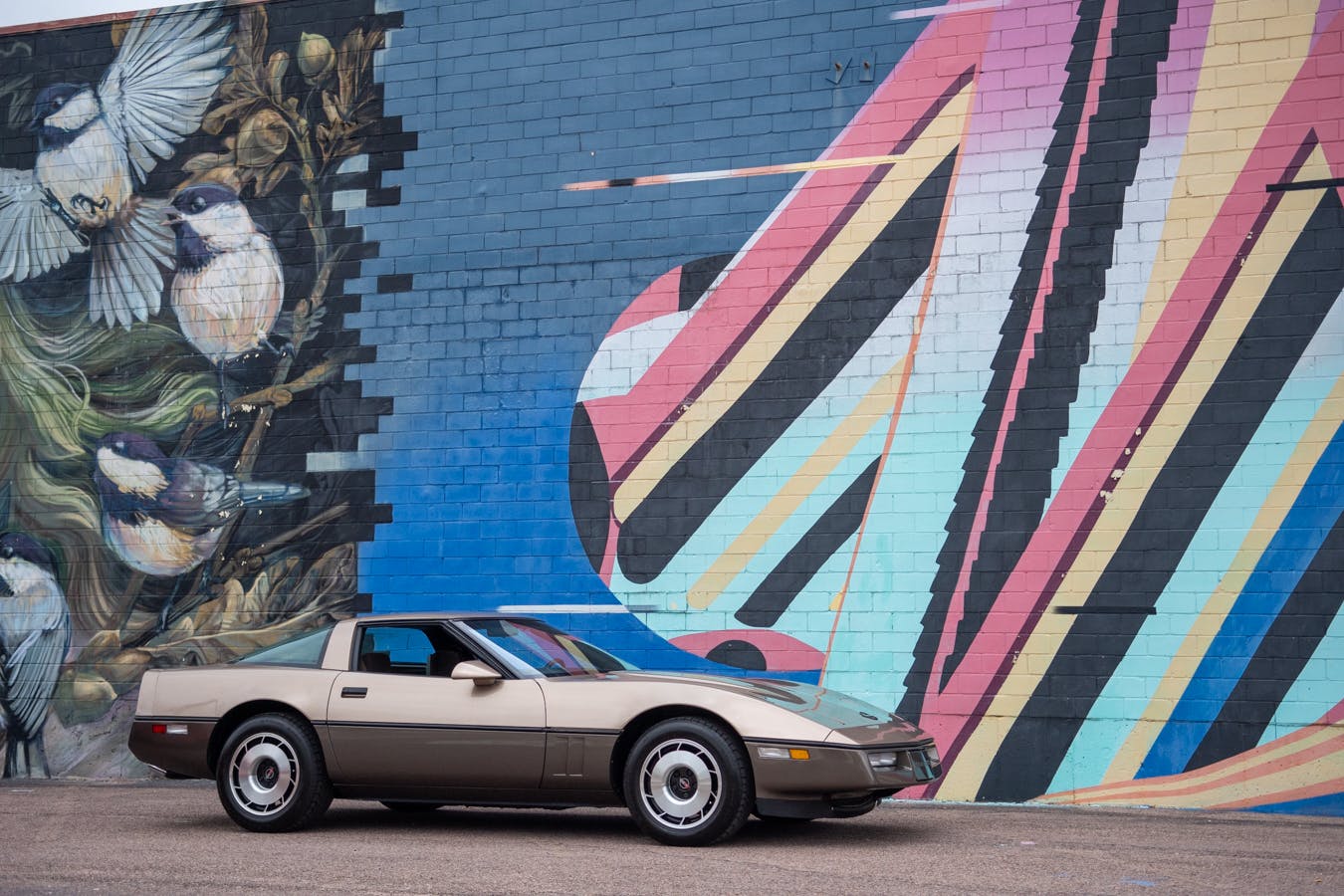
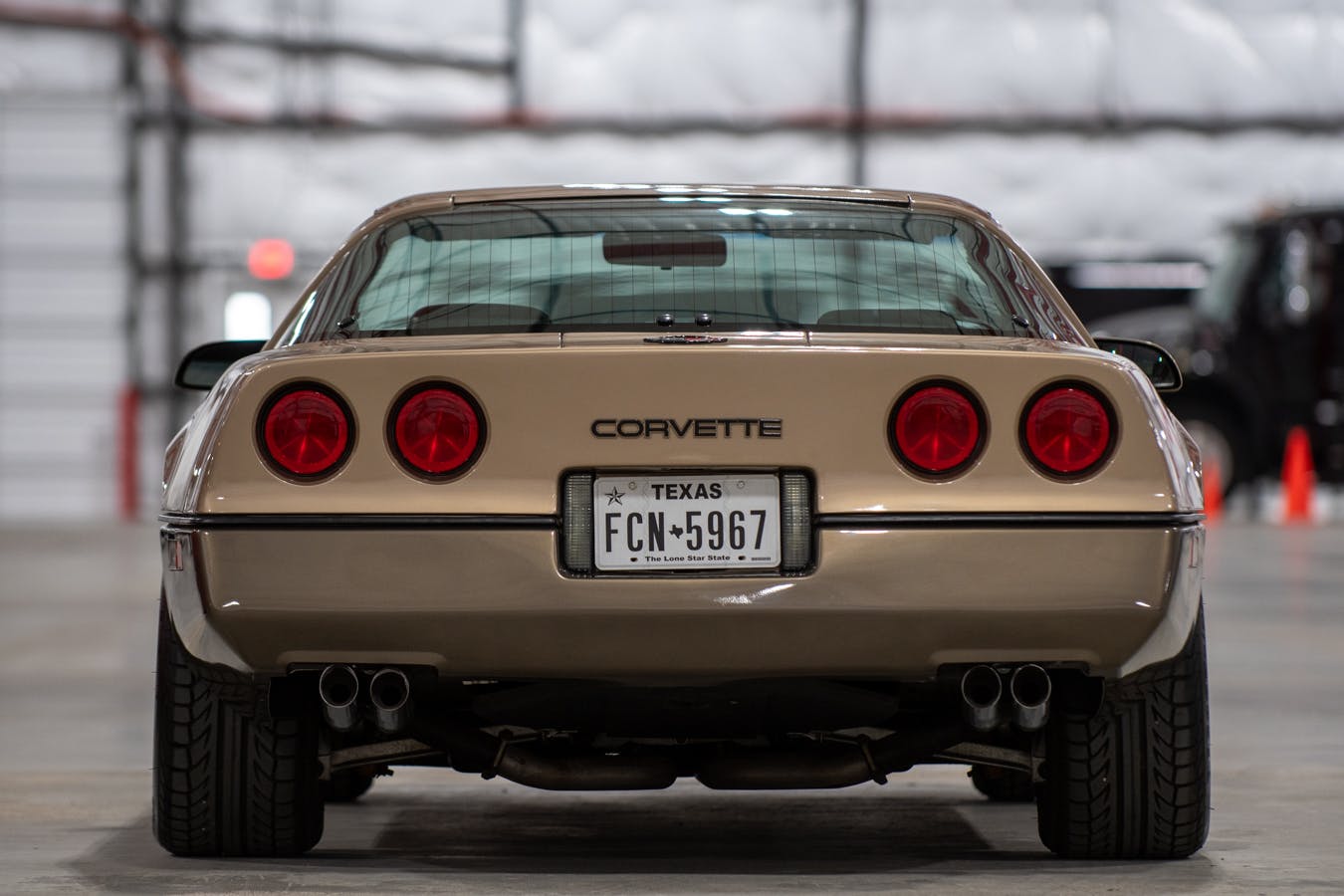
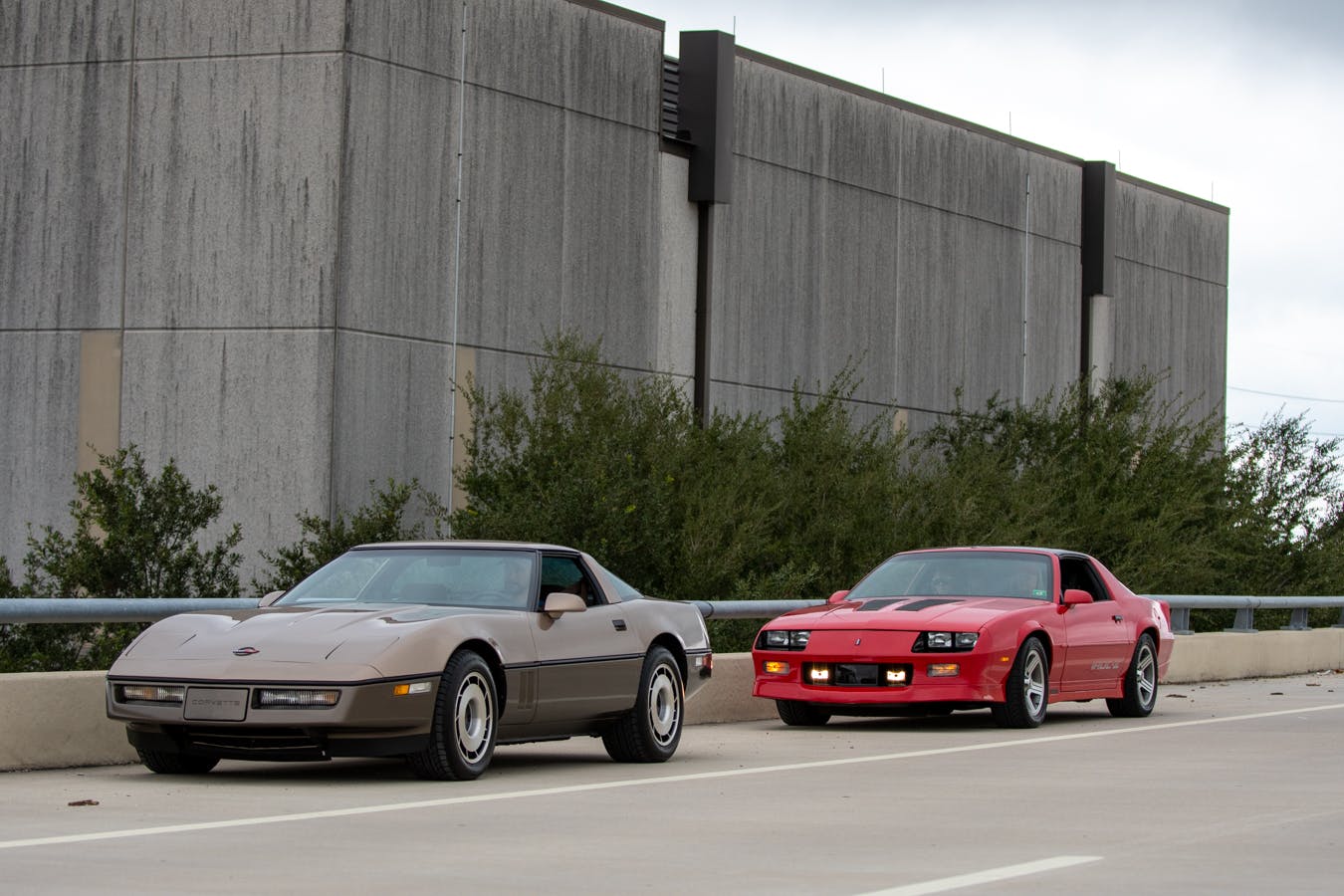
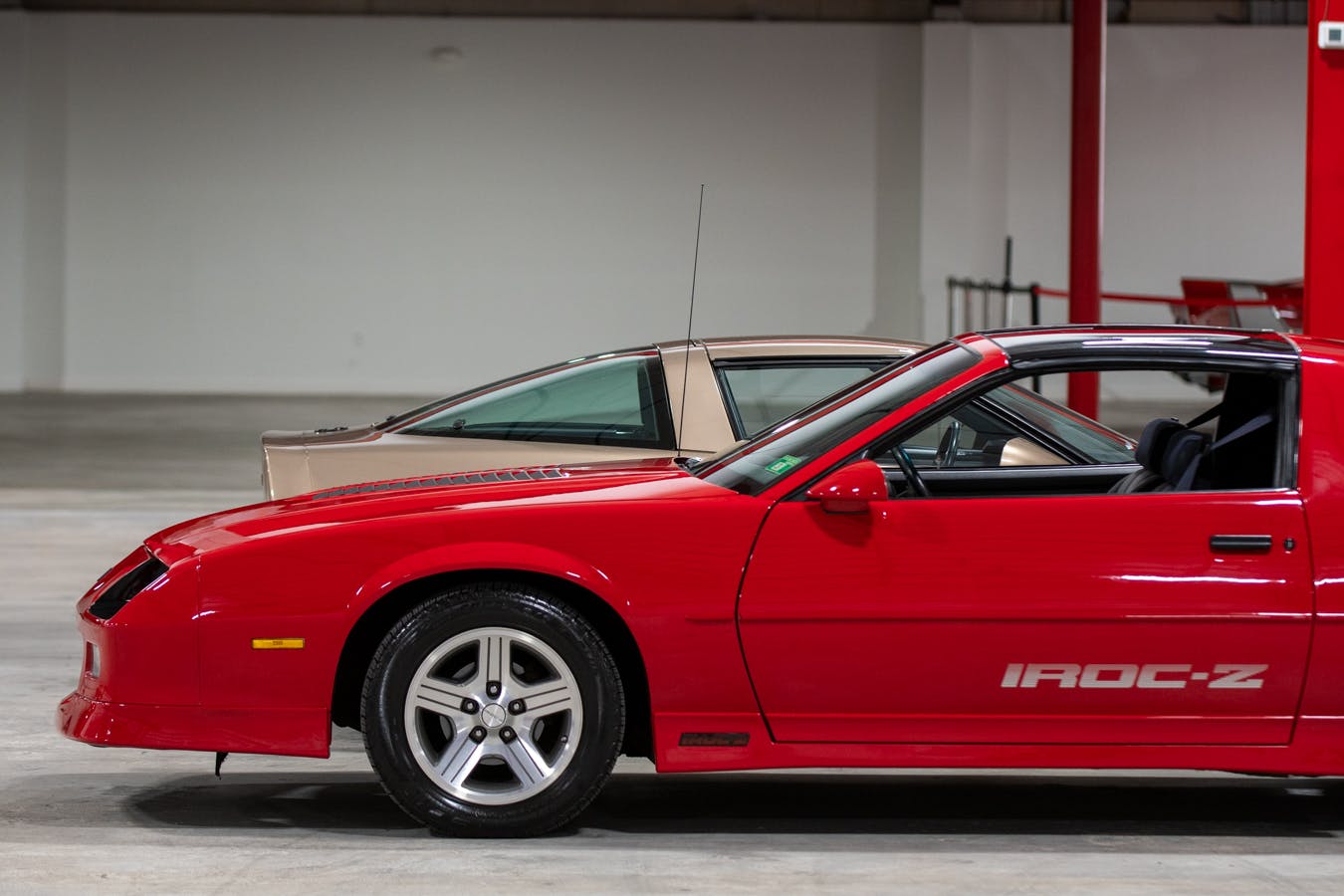
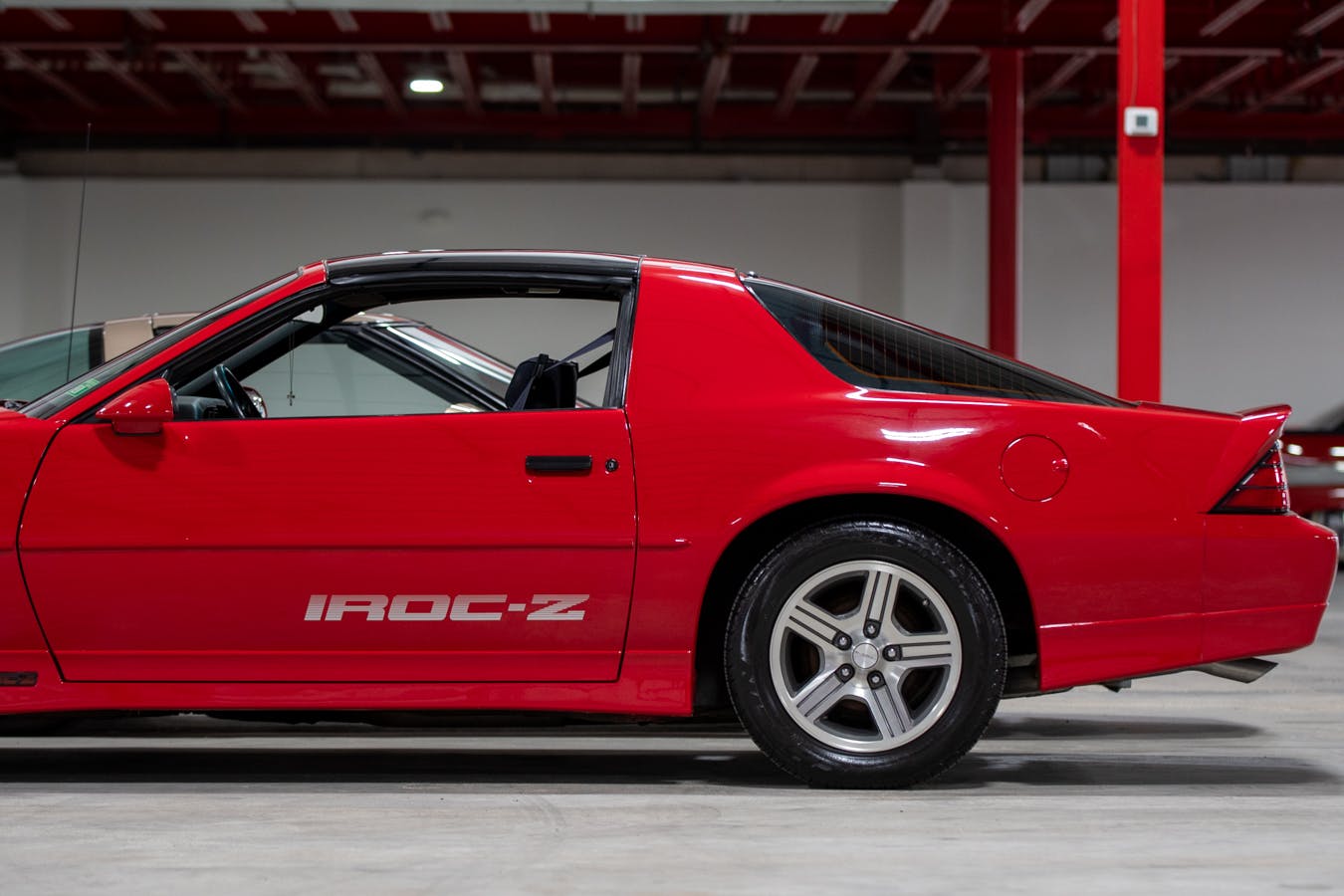
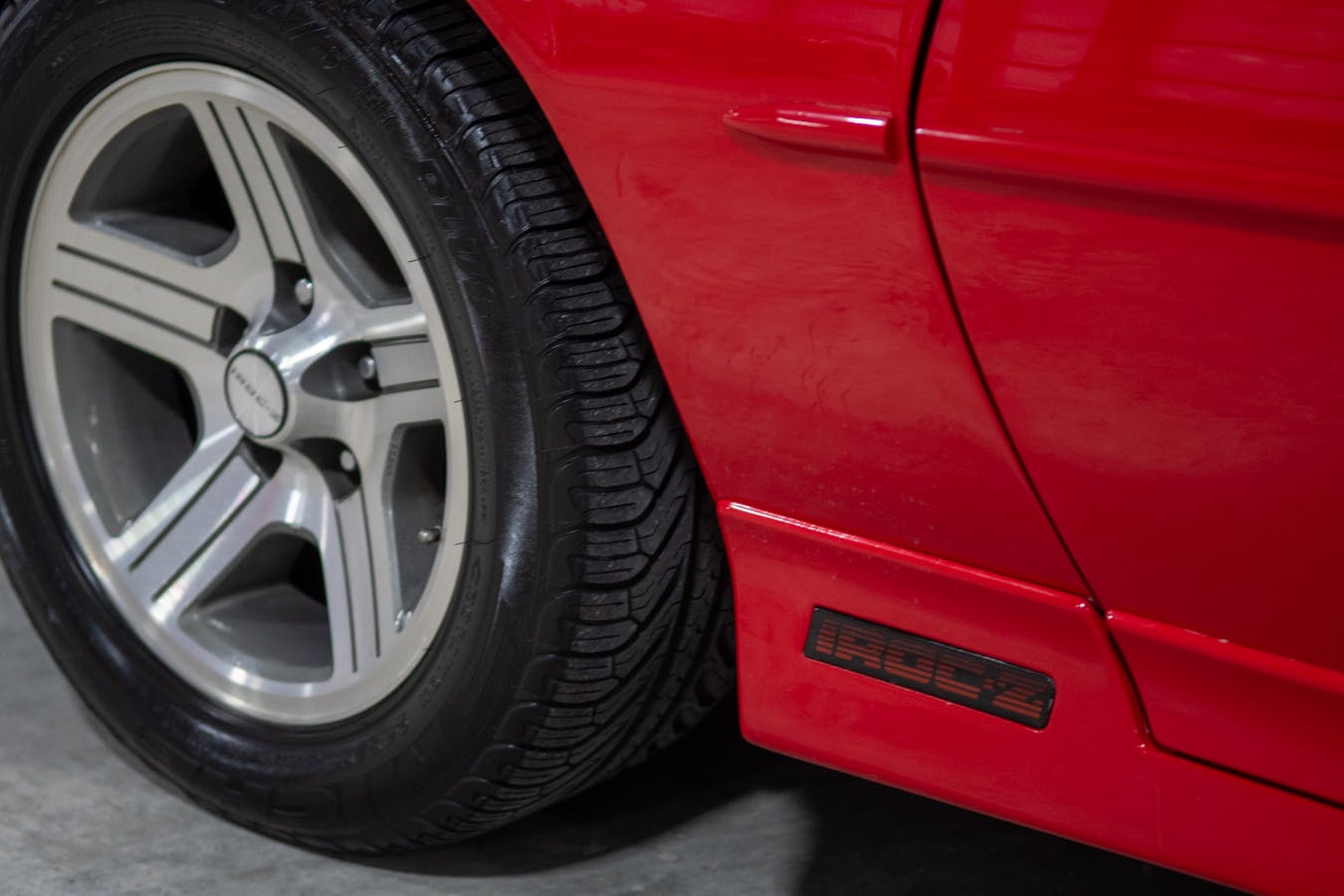
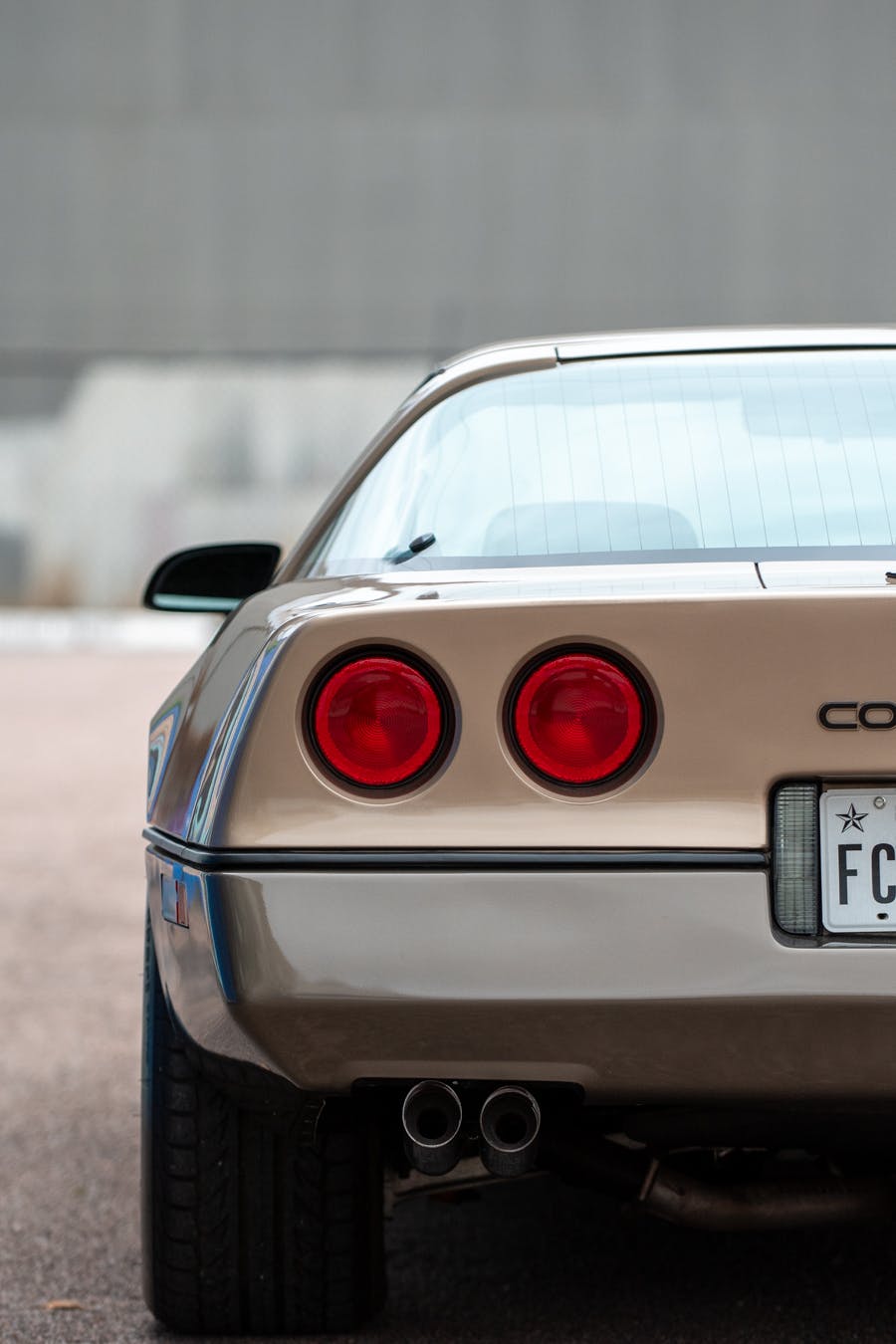
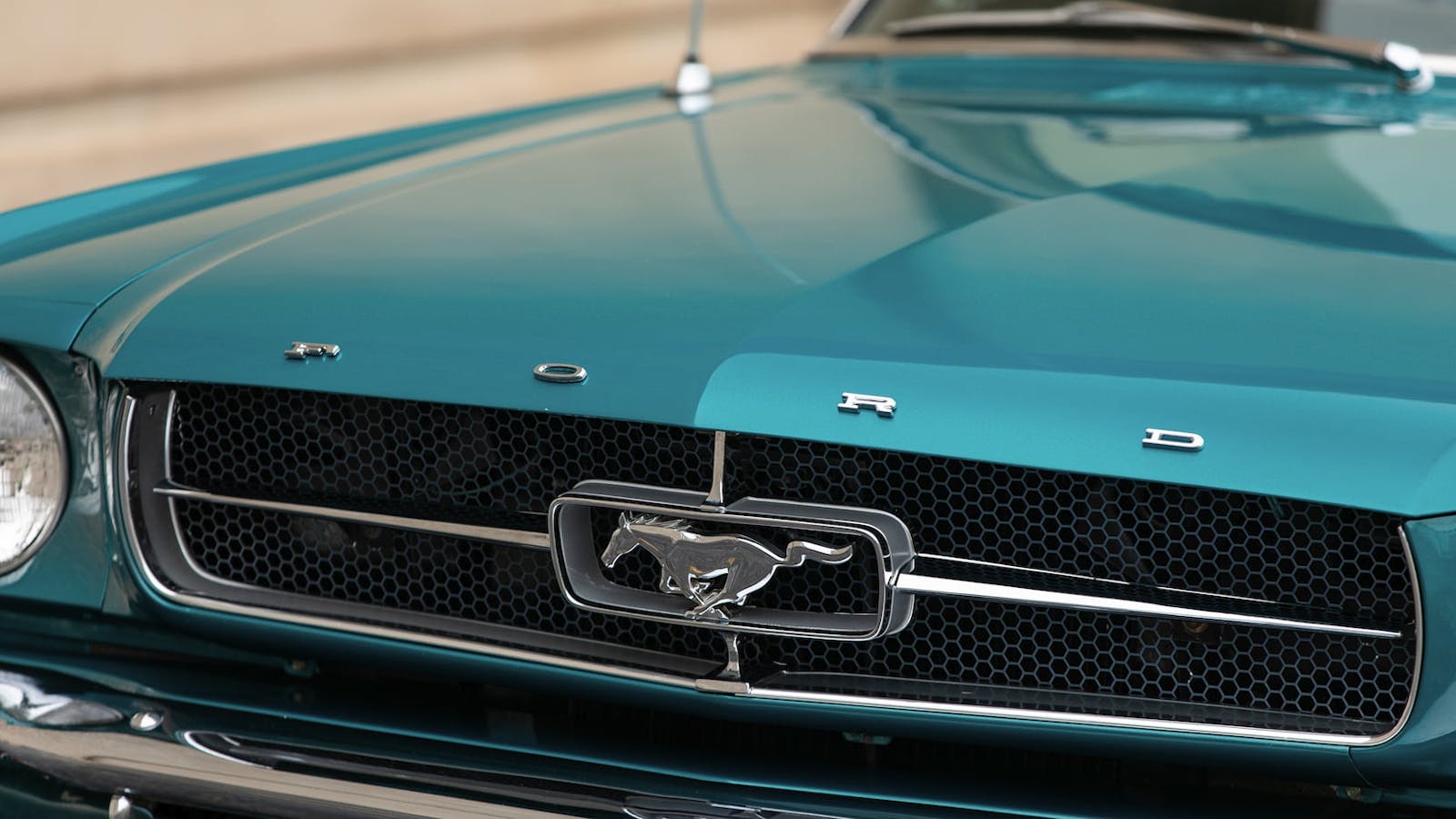

I have owned a 1985, 1986 & 1987 IROC. The 1987 was by far the best with the 5.7L. I still own my 1990 C4 with 14k miles and ZF 6-speed. Awesome performer even today. Recently bought a 1985 IROC with 4k miles in bright blue just like I had in 1985. I get to enjoy both worlds.
I didn’t read this entire article because I have the attention span of a 2 year old, but, the Vette just looks dated, the “futuristic” rims were always ugly on that car, (it looked much better when they introduced the 5 spoke). I also believe they offered these Vettes with a 2 tome paint job,.(Yuck) Whereas the design of that generation Camaro has stood the test of time.
Better to have a family than a costlier car that can’t haul kids. Hell, I had seversl second gen and third gen Camaros before I had a family, Vettes are overpriced, especially since you get less car and fewer seats with no extra power. The IROCs can tuck 315s front and rear, if done precisely right. No Vette can.
So the IROCs can corner harder, too. Let’s talk rear end. On the Vette, the Dana 44 is as good as it gets. In the IROC, you can order direct bolt-ins including the 12-bolt, the Ford 9″, and the Dana 60, thanks to Strange and others. Brakes? Baer has you covered. The Camaro has more potential. And there are more of them.
Everyone who buys a Corvette keeps it nice, nobody bought a Camaro to garage and cover it. Camaros were driven hard and CHEAP forever. The same pricing is occuring with c5s and 4th gen f bodies. There’s just way less nice ones out there. I’ve owned c4s, they handle well but that’s about it. Interior is awful, getting in and out is horrible and with no backseat, you can’t cruise around with your friends. They just don’t represent a pinnacle of anything, the c5 is significantly better at everything. The 3rd gen Camaro/trans am is more useful, who cares about speed both are absolute turds in today’s world.
I’m 31 for reference, I’ve never wanted a C4. I only bought one because it was dirt cheap. I currently have a 01 formula and 99 T/A, for the same price as a janky C4, you can get a LS powered practical vehicle. I just think the C4 never had and never will have its day in terms of desirability. I’d much rather have a 944, Supra, Station, 300zx turbo, grand national…If I’m must buy an 80s car. The zr1 and lt4 cars will be worth something, regular c4s have peaked in value imo
Typical opinion of a 31 year old. I get it, but there are some of us 60 -70 year old duffers that recognize a different sort of value.
Very nicely written article and one I have found to be oh so true (unfortunately). I am still waiting for all the ones that have been driven hard to fade away such that the ones with true value can shine!
I have owned a 1985 first gen. IROC since 1986. 29,000 actual miles, black w/red cloth int. 305 TPI and T-tops. I’m 76 yrs. old now and I think it’s time to part with it. It’s like a member of the family, hate to see it go.
Great article.
Look at those cars. The c4 looks like garbage. The wheels alone make me depressed. That iroc looks like something Superman drives.
I had a 92 camero rs with the garbage 305 tbi and auto. Looked cool but was really lame.
Then i got a 99 frc 6 speed c5 for 18k in 2006. GM finally did something right with the c5
You don’t buy an old iroc for its performance. You buy it cause it’s the best damn American thing you can do in 2024.
But I’m not paying those prices for either. I’d rather drive another miata as much as it hurts my soul to say that. Or an 88 mustang gt
I have 3 third gen Camaros a 86 iroc a 91z28 and a 92 rs they all are fun cars to drive I work on them my self I had a few different firebirds and Camaros over the years I have always had a love for these cars now that I am older but not old in my late 30s my children are in highschool now they drive them and love them and the attention these cars give. I believe they are fast And loud enough for driving around town and to car shows. On another note the Camaro has a better look then the c4 corvette and everybody loves a pretty car.
Simple supply and demand of quality cars. Excellent condition C4s are everywhere. IROCs were ragged out and prime examples are hard to come by. A number 1 IROC is much more rare.
Well, I recently picked up my 92 RS heritage edition t-top ride from a local kid. Has the 305 h.o. and the transmission is lagging when first entering gear. I plan on getting the 480hp LS connect and cruise package from Chevy and just redoing it. There’s almost no rust on it and it’s all sheet metal, no bondo. Kids will be kids, and replacing the old radio has left a hole in the dash and a nasty electrical draw somewhere. I’m 46 and have always loved the body style, so here I am, late gen X doing my thing with a gen 3 Camaro. It’s not a mid life crisis, it’s a mid life project that’ll last for a couple decades!
Lots of comments about the old c4. I’ve owned my 95 Lt1 for over 20 years. It is a 6 speed car torch red with
black and red interior and a targa top. Could of bought this car new from Bill Heard Chevy but had three young kids at the time. Five years later same car 30 thousand miles on it excellent shape came into my view
I bought it without a second thought of what the market said or was saying I liked it. Still runs good looks even better. I have the original book and tape on how to get in and out of this car. Never kept outside in rain
always garage kept. With 71000 miles on it and a trickle charger it is ready to go. At 71 yrs. old with
arthritis pain I drive once and a while. It comes down to choice what do you like. Say what you want about this C4 it is fast and to me a very good looking car for the money. Brand new Nitto tires just sitting and waiting for a run. I like to ride the beltway on cruise control CD playing top in back on a sun shinny day. You are right I’m a boomer but I bet even with the negative press on this car a lot of people would like to afford
a corvette regardless of what is said. An American icon not going away. Just for kicks I think the 2023 mid engine corvettes are ugly. Fast yes not much appeal to me. I never by into the hype If I like that is all that matters. I had a friend that bought a 75 javelin thought it was the second coming go figure that. CHOICE,